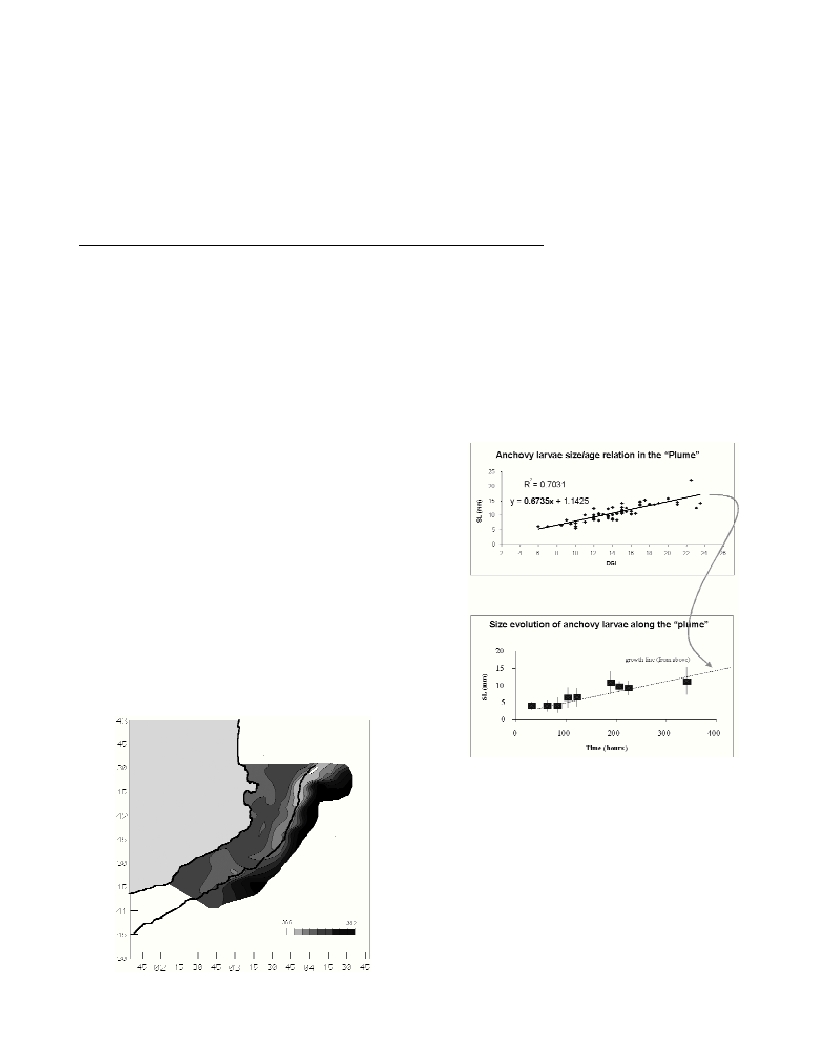LAGRANGIAN TRACKING OF LOW SALINITY SURFACE WATERS FROM THE GULF OF LIONS AND
ADVECTION OF ANCHOVY LARVAE ALONG THE CATALAN SLOPE (NW MEDITERRANEAN)
A. Sabatés
1*
, J. Salat
1
, I. Palomera
1
, M.P. Olivar
1
and M.L. Fernández de Puelles
2
1
ICM-CSIC., Barcelona, Spain - * sabates@icm.csic.es
2
IEO Balears, Palma de Mallorca, Spain
Abstract
The results of a Lagrangian survey of waters of continental origin from the Gulf of Lions are presented. Three drifters were launched at
the edge of the continental shelf around the core of the shelf-slope current and followed up to near Barcelona. The current was carrying
surface waters with relatively low salinity from the Gulf of Lions, in?uenced by Rhone runoff. Monitoring of environmental conditions,
planktonic communities and anchovy larvae living in the surface water parcel tracked by the drifters was conducted in order to evaluate
the suitability of these waters for the survival of anchovy larvae.
Keywords: NW Mediterranean, continental waters, advection, anchovy larvae, larval growth
Rapp. Comm. int. Mer Médit., 37,2004
432
Introduction
In the Mediterranean, once the seasonal thermocline has been
established by the end of spring, the nutrient content of surface waters
is rapidly exhausted and primary production can only be sustained at
deeper layers (1). Only at certain places, in conditions of favourable
winds for coastal upwelling or near river mouths, there can be some
nutrient input into the surface water allowing a relatively high
biological production. In the Catalan Sea, the spawning peak of
anchovy, Engraulis encrasicolus,takes place at the end of spring.
High egg and larval abundances are clearly associated with areas of
freshwater input (2). During the earliest stages of development
anchovy larvae are located near the surface (3). This coincidence is
related to: (i) the relative high production of these waters at the end of
spring, when the continental runoff reaches its annual maximum, and
(ii) the ability of these larvae to survive in a low salinity environment.
The continental shelf of the Gulf of Lions is in?uenced by water of
continental origin from the out?ow of the Rhône River. The stratifica-
tion conditions at the end of spring play a role, favouring a wide sprea-
ding of these continental waters, because the surface mixed layer is
still very thin. It is, then, not difficult to find these low salinity surface
water as far as more than 250 km away from the river mouth, down-
stream the shelf-slope current (5).
Data
A lagrangian survey was carried out in June 2000, during 10 days
in the northern Catalan coast. Three drifters were launched at the shelf
edge of the Gulf of Lions, around the core the shelf-slope current, and
followed up to near Barcelona, along a path of more than 200 km. The
current was carrying surface waters with relatively low salinity from
the Gulf of Lions. The objective was to monitor the environmental
conditions, planktonic communities and anchovy larvae living in the
surface water parcel tracked by the drifters and evaluate the suitability
of these waters for the survival of anchovy larvae. The experiment was
completed by a general survey of the whole area to compare the
situation inside and outside the tracked water.
Results
The general surface salinity distribution showed both relatively low
salinity and high ?uorescence waters over the drifters’path (Fig.1).
Concentration of copepod nauplii and copepodites, potential larval
fish food, did not show important variations along the experiment. At
the starting point of the drifters, high concentrations of small anchovy
larvae were detected, which were progressively decreasing in number,
while larval size increased along the survey track (Fig. 2). Larval
growth rates obtained through otolith microstructure analysis revealed
that mean size increased along the path and this corresponded well
with the time elapsed from the beginning of the experiment (Fig. 2).
This suggests that larval cohorts were growing inside the tracked
plume of continental in?uence.
References
1-Estrada, M., 1985. Deep phytoplankton and chorophyll maxima in the
Western Mediterranean. Pp. 247-277. In: Moraitou-Apostolopoulou, M.,
and Kortsis, V. (eds.), Mediterranean Marine Ecosystems,Plenum Press,
New York.
2-Palomera, I., 1992. Spawning of anchovy Engraulis encrasicolus, in
the North-Western Mediterranean relative to hydrographic features in the
region. Mar. Ecol. Prog. Ser.,79: 215-223.
3-Olivar, M.P., Salat, J. and Palomera, I., 2001. A comparative study of
the spatial distribution patterns of the early stages of anchovy and pilchard
in the NW Mediterranean Sea. Mar. Ecol. Prog. Ser.,217: 111-120.
4-Castellón, A., Salat, J. and Masó, M., 1985. Some observations on
Rhône fresh water plume in the Catalan Coast. Rapp. Com. Int.. Mer
Médit.,29: 3.
5-Sabatés, A., Salat, J., Olivar, M.P., 2001. Advection of continental
water as an export mechanism for anchovy, Engraulis encrasicolus,
larvae. Sci. Mar. 65: 77-88.
Fig. 1. Surface Salinity distribution showing the trajectory of the drifters
along the experiment.
Fig. 2. Anchovy larval growth and mean larval size (±SD) along the
experiment.

